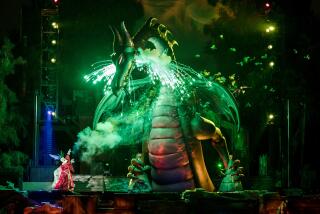Coming, Sooner or Later
- Share via
The idea to revise and update the animation classic “Fantasia” popped into Roy E. Disney’s head in 1974. Disney, the nephew of Walt Disney, proposed the concept to Disney Chairman Michael Eisner 10 years later. Production began in 1990 with a 1997 release date that had originally been planned to share the spotlight with “Hercules.”
But the road has been anything but smooth. The 32 minutes of footage being revised, added or updated on the 1940 film, which is now scheduled for a release in 2000, could go down as one of the most expensive films in history.
“Fantasia,” an animated mix of vignettes that are different artists’ interpretations of the works of musical masters, was slammed by critics when it was released for taking too many liberties with the original music. But the film became critically appreciated over time.
This time, the critics are at the studio itself. Some have put the price tag on the work to date at $100 million, and there are still at least two more years of work. The entire original film cost $2.2 million, which was four times the amount of the average live-action film in its day. While contemporary features like “Waterworld” and the coming “Titanic” reportedly can cost more than $200 million, those features are at least three times the length of what is being remade on “Fantasia.” And the average full-length animated film usually costs from $60 million to $80 million and is in production only four years.
The studio calls the $100-million number preposterous and considers the claims of a runaway budget the runaway imagination of uninformed employees.
But some who have worked on the film say they expect the number to climb higher than $100 million by the time the film, to be retitled “Fantasia 2000,” is released.
Said one studio source: “Look, this film is considered a national treasure. You figure they want the best directors working on it, and the top animators get about $350,000 a year, plus fringe benefits. If they are working on it for several years, that could run as high as several million dollars on one animator alone.” Factor in the 200 or so employees who float in and out of the production, and carrying costs of about 8% over a decade, and the numbers swell.
Compared to this year’s “Hercules,” one insider says, “This is one-third the amount of footage and it’s taking four times as long to make. What is this, a hobby?”
But Thomas Schumacher, executive vice president of Walt Disney feature animation and theatrical production, said he believes the internal rumors have everything to do with “people who just don’t understand the concept of what we are trying to do with this movie.” While he denied the $100-million amount, he declined to give a ballpark figure on what the additional footage has and will cost. He said simply: “We don’t release numbers here.”
Schumacher said that when Walt Disney created the original film, “He wanted it to be a piece of work that would be constantly augmented over time . . . an ongoing project. The idea was to pull out some pieces and add in new ones with interpretations by present-day artists.”
*
In the beginning of the original film, narrated by Deems Taylor with music conducted by Leopold Stokowski and performed by the Philadelphia Orchestra, the audience is told: “This is a new form of entertainment. What you are going to see are the designs and pictures and stories that music inspired in the minds and imaginations of a group of artists.” Interpreted were three types of music: “the kind that tells a definite story; the kind that has no specific plot but paints a series of definite pictures; and music that exists simply for its own sake . . . abstract music.”
When “Fantasia 2000” is unveiled, Schumacher said, moviegoers will see six new pieces--three of which are completed. “What people just can’t seem to understand is that we have never set ‘Fantasia’ up like a regular feature film. We use artists to work on it who are available at different times.”
In fact, clips of one of the additions, Ottorino Respighi’s “Pines of Rome,” have already been shown to some animators and computer graphics experts outside Disney, he said. “It’s really a beautiful interpretation by [animation director] Hendel Butoy. It has whales taking flight following an explosion of a supernova. It is a combination of computer and traditional cel animation.”
Among the other new segments, with music conducted by James Levine of the Metropolitan Opera and performed by the Chicago Symphony Orchestra: Dmitri Shostakovich’s “The Steadfast Tin Soldier,” directed by Butoy; Sir Edward Elgar’s “Pomp and Circumstance,” directed by Francis Glebas; Igor Stravinsky’s “The Firebird Suite,” directed by Paul and Gaetan Brizzi; Camille Saint-Saen’s “Carnival of the Animals,” directed by Eric Goldberg; and Beethoven’s Fifth Symphony, the artist and director for which have not yet been determined.
“You will see 3-D computer animation in these,” Schumacher said. “The whole point is to have different animators to flow in and out of this project, giving them time to work on this when they are in between other projects. This is in keeping with the original plan. Look at the original film--’Dance of the Hours,’ ‘Toccata in Fugue,’ ‘A Night on Bald Mountain’ were all done by different animators.
“It is great for the artists,” he says, “since animators rarely get to do their own piece.” Contrary to what some believe, he said, “it allows us to keep the production [staff] very lean and very small.”
More to Read
Only good movies
Get the Indie Focus newsletter, Mark Olsen's weekly guide to the world of cinema.
You may occasionally receive promotional content from the Los Angeles Times.










